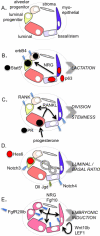Fully interlocking: a story of teamwork among breast epithelial cells
- PMID: 24480641
- PMCID: PMC3990361
- DOI: 10.1016/j.devcel.2014.01.011
Fully interlocking: a story of teamwork among breast epithelial cells
Abstract
In this issue of Developmental Cell, Forster et al. (2014) show that the basal myoepithelial cell layer directs the final maturation of the adjacent luminal cell sheet during pregnancy. Do all mammary epithelial cells both give and take instructions from others to create the milk production machinery?
Copyright © 2014 Elsevier Inc. All rights reserved.
Figures

Comment on
-
Basal cell signaling by p63 controls luminal progenitor function and lactation via NRG1.Dev Cell. 2014 Jan 27;28(2):147-60. doi: 10.1016/j.devcel.2013.11.019. Epub 2014 Jan 9. Dev Cell. 2014. PMID: 24412575 Free PMC article.
References
Publication types
MeSH terms
Substances
Grants and funding
LinkOut - more resources
Full Text Sources
Other Literature Sources

